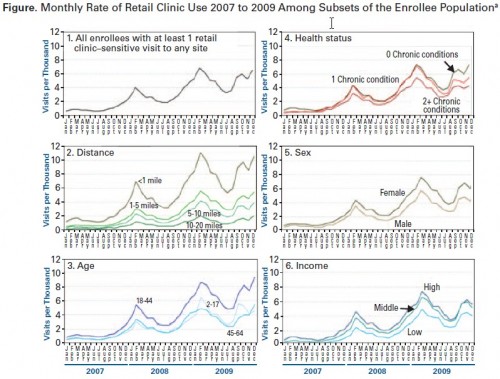Walmart was for dominating the retail medical clinic market before it was against it. I don’t really know what they’re going to do, but I know a bit about the potential for retail clinics to address health care spending and the analytic issues associated with addressing that issue.
The latest work is from J. Scott Ashwood, Rachel Reid, Claude Setodji, Ellerie Weber, Martin Gaynor, and Ateev Mehrotra. They analyzed 2007-2009 outpatient Aenta insurance claims for 13,3 million non-elderly patients in 22 markets. The following figure summarizes their findings (click for larger image).
Some points, many obvious, for each of the six panels:
- Retail clinic use has grown considerably over study period. There are clear seasonal effects, greater use in the cooler months, as one would expect.
- Retail clinic use is considerably higher for those living very close to one. This makes sense since the whole point is convenience.
- Retail clinic use is dominated by young adults. (Can we please say that 44 is still young?)
- Those with two or more chronic conditions are less likely to use a retail clinic.
- Women are more likely to use one. I don’t know why. Is it because they tend to shop more than men? (Is that even true or am I falling for a sexist stereotype?) Is it because women are more likely to take children to the doctor (another sexist stereotype?) and, in doing so, use the same provider?
- Low income individuals are less likely. Perhaps those with higher incomes place a greater value on convenience and the time savings of retail clinics. (Update: In the comments, it is noted that retail clinics may locate in higher income areas.)
Points 3 and 4 are consistent with the well-known favorable selection of retail clinics. It’s why one should not naively compare health care costs associated with retail clinic users and non-users, at least not for the purposes of concluding that retail clinics cause lower health spending.
That is not to say that retail clinics don’t provide care at lower cost. They do. But whether they can substantially address the problem of growing US health care costs depends on other factors, as the authors explain:
Care initiated at retail clinics is 30% to 40% cheaper than similar care at physician offices and approximately 80% cheaper than similar care at emergency departments. If the growth in retail clinic visits we observed represents substitution for other sources of care, then the increase in retail clinic use could lead to lower costs. However, if these visits represented new utilization (ie, patients seeking care when previously they would have stayed at home), then costs could increase.
As one who is annoyed by the inconvenience of seeing medical professionals (mostly the time required to do so), I’d be delighted to have access to more retail clinics. Pending further study, I am agnostic as to whether they will lead to higher or lower health spending.



